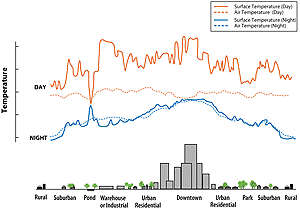Learn About Heat Islands
As urban areas develop, changes occur in their landscape. Buildings, roads, and other infrastructure replace open land and vegetation. Surfaces that were once permeable and moist become impermeable and dry. These changes cause urban regions to become warmer than their rural surroundings, forming an "island" of higher temperatures in the landscape.
Heat islands occur on the surface and in the atmosphere. On a hot, sunny summer day, the sun can heat dry, exposed urban surfaces, such as roofs and pavement, to temperatures 50–90°F (27–50°C) hotter than the air1, while shaded or moist surfaces—often in more rural surroundings—remain close to air temperatures. Surface urban heat islands are typically present day and night, but tend to be strongest during the day when the sun is shining.
In contrast, atmospheric urban heat islands are often weak during the late morning and throughout the day and become more pronounced after sunset due to the slow release of heat from urban infrastructure. The annual mean air temperature of a city with 1 million people or more can be 1.8–5.4°F (1–3°C) warmer than its surroundings.2 On a clear, calm night, however, the temperature difference can be as much as 22°F (12°C).3
 Note: The temperatures displayed above do not represent absolute temperature values or any one particular measured heat island. Temperatures will fluctuate based on factors such as seasons, weather conditions, sun intensity, and ground cover.
Note: The temperatures displayed above do not represent absolute temperature values or any one particular measured heat island. Temperatures will fluctuate based on factors such as seasons, weather conditions, sun intensity, and ground cover.
Surface and atmospheric temperatures vary over different land use areas. Surface temperatures vary more than air temperatures during the day, but they both are fairly similar at night. The dip and spike in surface temperatures over the pond show how water maintains a fairly constant temperature day and night, due to its high heat capacity.
The heat island sketch pictured here shows how urban temperatures are typically lower at the urban-rural border than in dense downtown areas. The graphic also show how parks, open land, and bodies of water can create cooler areas within a city.
References
1 Berdahl P. and S. Bretz. 1997. Preliminary survey of the solar reflectance of cool roofing materials. Energy and Buildings 25:149-158.
2 Oke, T.R. 1997. Urban Climates and Global Environmental Change. In: Thompson, R.D. and A. Perry (eds.) Applied Climatology: Principles & Practices. New York, NY: Routledge. pp. 273-287.
3 Oke. T.R. 1987. Boundary Layer Climates. New York, Routledge.
